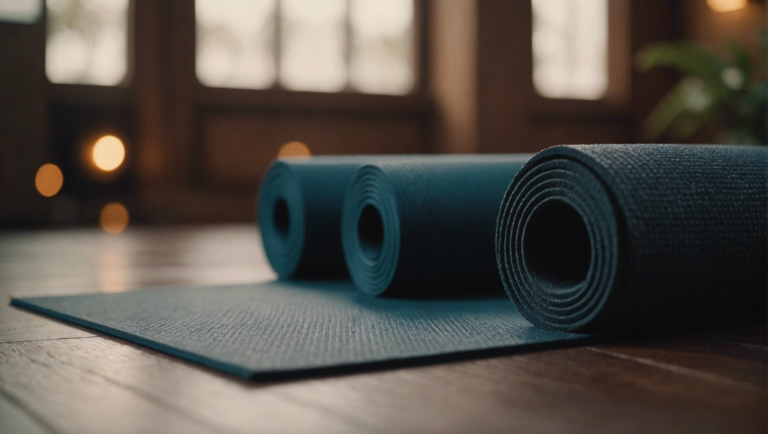Step-by-Step Guidelines: How To Clean Yoga Mats At Home
Step-by-Step Guidelines on How to Clean Yoga Mats at Home
Yoga mats are essential tools for anyone who practices yoga, providing a comfortable and non-slip surface for various poses and exercises. However, due to regular use, yoga mats can accumulate sweat, dirt, and bacteria over time. It’s crucial to clean your yoga mat regularly to maintain hygiene and extend its lifespan. In this guide, we will provide you with step-by-step guidelines on how to effectively clean your yoga mat at home.
Materials Needed to Clean Your Yoga Mat
Before you begin the cleaning process, gather the necessary materials:
- Mild detergent or yoga mat cleaner
- Water
- Soft cloth or sponge
- Towel for drying
- Essential oils (optional for fragrance)
Step 1: Prepare the Cleaning Solution
Start by preparing a cleaning solution for your yoga mat. Mix a few drops of mild detergent or a yoga mat cleaner in a bowl of water. You can also add a few drops of essential oils like lavender or tea tree oil for a pleasant fragrance.
Step 2: Wipe Down the Yoga Mat
Dampen a soft cloth or sponge with the cleaning solution. Gently wipe down the entire surface of the yoga mat, ensuring that you cover all areas. Pay extra attention to spots that have visible dirt or stains.
Step 3: Rinse the Mat
Once you have wiped down the mat, rinse it thoroughly with clean water to remove any soap residue. You can rinse the mat in the bathtub or with a hose outdoors. Make sure to rinse until the water runs clear, indicating that all the soap has been removed.
Step 4: Dry the Yoga Mat
After rinsing, use a clean towel to absorb excess water from the mat. Avoid wringing the mat, as this can damage its texture. Instead, gently press the towel against the mat to soak up the moisture.
Step 5: Air Dry the Mat
To complete the cleaning process, hang the yoga mat to air dry in a well-ventilated area. Avoid direct sunlight, as prolonged exposure can cause the mat to deteriorate. Once the mat is completely dry, roll it up and store it in a clean and dry place.
Additional Tips for Yoga Mat Maintenance
- Consider using a yoga mat spray between cleanings to keep your mat fresh and germ-free.
- Avoid using harsh chemicals or abrasive scrubbers, as they can damage the mat’s surface.
- Regularly rotate your yoga mat to ensure even wear and tear.
- Check the manufacturer’s instructions for specific cleaning recommendations for your type of yoga mat.
By following these simple yet effective steps, you can keep your yoga mat clean, hygienic, and ready for your next yoga session. Regular cleaning not only maintains the quality of your mat but also contributes to a healthier practice environment. Incorporate these cleaning guidelines into your routine to enjoy a clean and fresh yoga experience every time.
Benefits of Regularly Cleaning Yoga Mats
Regularly cleaning your yoga mat is essential not only for maintaining hygiene but also for extending its lifespan and improving your overall yoga experience. By following simple step-by-step guidelines, you can effectively clean your yoga mat at home, ensuring that it remains fresh and ready for your next practice session.
Importance of Clean Yoga Mats
Cleaning your yoga mat regularly offers a multitude of benefits, both in terms of your health and yoga practice. A clean mat provides a more pleasant and hygienic surface for your yoga practice, preventing the buildup of bacteria, germs, and odor. Additionally, a clean mat offers better traction, reducing the risk of slipping during poses and enhancing your overall stability and balance.
Step-by-Step Guidelines for Cleaning Yoga Mats at Home
Step 1: Gather Your Cleaning Materials
Before you begin cleaning your yoga mat, gather the necessary materials. You will need a gentle detergent, water, a clean cloth or sponge, and a soft-bristled brush, such as a brush specifically designed for yoga mats.
Step 2: Prepare the Cleaning Solution
Create a cleaning solution by combining water with a small amount of gentle detergent. Avoid using harsh chemicals or soaps that may damage the mat’s surface or leave behind residue that can affect your skin during practice.
Step 3: Wipe Down the Mat
Dampen a clean cloth or sponge with the cleaning solution. Gently wipe down the surface of the yoga mat, covering the entire area. Focus on areas that come into direct contact with your hands and feet during practice.
Step 4: Scrub Stubborn Stains
For stubborn stains or areas with heavy dirt buildup, use a soft-bristled brush to gently scrub the surface of the mat. Avoid using excessive force to prevent damaging the mat’s texture or material.
Step 5: Rinse the Mat
Once you have cleaned the entire surface of the mat, rinse it thoroughly with clean water to remove any soap residue. Ensure that all detergent is washed away to prevent slipping during your next practice.
Step 6: Air Dry the Mat
Allow the yoga mat to air dry completely before rolling it up for storage. Avoid exposing the mat to direct sunlight or high heat, as this can damage the material over time.
Regularly cleaning your yoga mat is a simple yet crucial aspect of maintaining a healthy and enjoyable yoga practice. By following these step-by-step guidelines for cleaning your yoga mat at home, you can ensure that your mat remains clean, fresh, and ready for your next session. Prioritizing the cleanliness of your yoga mat not only enhances your practice but also contributes to your overall well-being.
Different Methods for Cleaning Yoga Mats Effectively
Importance of Using Natural Cleaning Agents for Yoga Mats
Tips for Storing and Maintaining Clean Yoga Mats
Conclusion
Proper maintenance of yoga mats is essential for your health and well-being. By following the step-by-step guidelines on how to clean yoga mats at home, you can ensure that your yoga practice remains hygienic and enjoyable. Regular cleaning not only prolongs the lifespan of your mat but also prevents the build-up of bacteria and germs.
Moreover, the benefits of regularly cleaning yoga mats go beyond hygiene. Clean mats provide a better grip, enhancing your stability and focus during practice. This improves the overall yoga experience and helps you achieve the full benefits of each session. Additionally, a fresh-smelling mat can contribute to a calming and pleasant atmosphere during your yoga practice.
When it comes to cleaning yoga mats, there are various methods you can choose from. Whether you opt for a simple DIY solution using household items or prefer natural cleaning agents like vinegar and essential oils, it’s important to select a method that suits your preferences and the material of your mat. Each cleaning method has its own advantages, so feel free to experiment and find what works best for you.
Using natural cleaning agents for yoga mats is highly recommended due to their gentle yet effective properties. Natural ingredients such as vinegar, baking soda, and essential oils not only clean the mat but also help maintain its texture and integrity. These eco-friendly alternatives are safer for both your health and the environment, making them a popular choice among yoga practitioners.
In addition to cleaning, proper storage and maintenance are crucial for preserving the quality of your yoga mat. Storing your mat in a cool, dry place away from direct sunlight and moisture can prevent mold and mildew growth. Rolling your mat rather than folding it can also help maintain its shape and prevent creases. Furthermore, periodically airing out your mat and spot-cleaning any stains can prolong its lifespan and keep it looking fresh.
By following these tips and guidelines for cleaning and maintaining your yoga mat, you can create a clean and inviting space for your practice. With a fresh and hygienic mat, you can fully immerse yourself in the therapeutic benefits of yoga and focus on your mental and physical well-being. Remember, a clean mat is not just a surface for your practice—it’s a foundation for your wellness journey.

